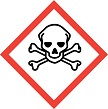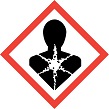GHS Classification Result
GENERAL INFORMATION
REFERENCE INFORMATION
PHYSICAL HAZARDS
HEALTH HAZARDS
ENVIRONMENTAL HAZARDS
NOTES:
Updated date:
GENERAL INFORMATION
| Item | Information |
|---|---|
| CAS number | 13523-86-9 |
| Chemical name | Pindolol |
| Substance ID | 23A5144 |
| Fiscal year of classification conducted | FY2011 |
| Classifier(s) (Ministries) | Ministry of Health, Labour and Welfare (MHLW), Ministry of the Environment (MOE) |
| New/Revised | New |
| Download in Excel format | Excel file |
| Item | Information |
|---|---|
| Guidance used for classification (External link) |
Physical Hazards & Health Hazards: GHS Classification Guidance by the Japanese Government (July, 2010)
Environmental Hazards: UN GHS Document (4th revised edition) |
| Definitions / Abbreviations (Excel file) | Definitions / Abbreviations |
| Model Label by MHLW (External link) | MHLW Website (in Japanese Only) |
| Model SDS by MHLW (External link) | MHLW Website (in Japanese Only) |
| OECD/eChemPortal (External link) | eChemPortal |
| Hazard class | Classification |
Pictogram (Code: symbol) Signal word |
Code (Hazard statement) |
Code (Precautionary statement) |
Rationale for the classification | |
|---|---|---|---|---|---|---|
| 1 | Explosives | Not applicable | - | - | - | There are no chemical groups associated with explosive properties present in the molecule. |
| 2 | Flammable gases (including chemically unstable gases) | Not applicable | - | - | - | "Solids" according to GHS definition. |
| 3 | Aerosols | Not applicable | - | - | - | Not an aerosol product. |
| 4 | Oxidizing gases | Not applicable | - | - | - | "Solids" according to GHS definition. |
| 5 | Gases under pressure | Not applicable | - | - | - | "Solids" according to GHS definition. |
| 6 | Flammable liquids | Not applicable | - | - | - | "Solids" according to GHS definition. |
| 7 | Flammable solids | Classification not possible | - | - | - | No data. |
| 8 | Self-reactive substances and mixtures | Not applicable | - | - | - | There are no chemical groups present in the molecule associated with explosive or self-reactive properties. |
| 9 | Pyrophoric liquids | Not applicable | - | - | - | "Solids" according to GHS definition. |
| 10 | Pyrophoric solids | Classification not possible | - | - | - | No data. |
| 11 | Self-heating substances and mixtures | Classification not possible | - | - | - | No data. |
| 12 | Substances and mixtures which, in contact with water, emit flammable gases | Not applicable | - | - | - | Not containing metals or semimetals (B, Si, P, Ge, As, Se, Sn, Sb, Te, Bi, Po, At). |
| 13 | Oxidizing liquids | Not applicable | - | - | - | "Solids" according to GHS definition. |
| 14 | Oxidizing solids | Not applicable | - | - | - | It does not contain fluorine or chlorine but contains oxygen which is not chemically bonded to elements other than carbon or hydrogen. |
| 15 | Organic peroxides | Not applicable | - | - | - | An organic compound that does not contain -O-O- structure. |
| 16 | Corrosive to metals | Classification not possible | - | - | - | No established test method suitable for solid substances. |
| Hazard class | Classification |
Pictogram (Code: symbol) Signal word |
Code (Hazard statement) |
Code (Precautionary statement) |
Rationale for the classification | |
|---|---|---|---|---|---|---|
| 1 | Acute toxicity (Oral) | Category 3 |  |
H301 |
P301+P310 P264 P270 P321 P330 P405 P501 |
From LD50 values of 263.3 mg/kg (males) and 269.6 mg/kg (females) for rats (RTECS (2010), original literature Niigata Igakkai Zasshi. Niigata Medical Journal: 84, 438, 1970) with confirmation of the description in the original literature, it was classified in Category 3. |
| 1 | Acute toxicity (Dermal) | Classification not possible | - | - | - | No data. |
| 1 | Acute toxicity (Inhalation: Gases) | Not applicable | - | - | - | "Solids" according to GHS definition. |
| 1 | Acute toxicity (Inhalation: Vapours) | Classification not possible | - | - | - | No data. |
| 1 | Acute toxicity (Inhalation: Dusts and mists) | Classification not possible | - | - | - | No data. |
| 2 | Skin corrosion/irritation | Classification not possible | - | - | - | No data. |
| 3 | Serious eye damage/eye irritation | Classification not possible | - | - | - | No data. |
| 4 | Respiratory sensitization | Classification not possible | - | - | - | No data. |
| 4 | Skin sensitization | Classification not possible | - | - | - | No data. |
| 5 | Germ cell mutagenicity | Classification not possible | - | - | - | No data. |
| 6 | Carcinogenicity | Classification not possible | - | - | - |
Lack of data. Besides, a 2-year oral administration carcinogenicity test in rats and mice reported that this substance did not cause any neoplastic, preneoplastic, or nonneoplastic pathologic lesions (HSDB (2004)), but it was classified as "Classification not possible" due to no further details. |
| 7 | Reproductive toxicity | Category 2, Additional category: Effects on or via lactation |  |
H361 H362 |
P308+P313 P201 P202 P281 P405 P501 P260 P263 P264 P270 |
In a reproductive toxicity test by oral administration in rats prior to mating, decreased mating associated with testicular atrophy or decreased spermatogenesis in addition to deaths and decreased weight gain in paternal animals and decreased mating behavior in maternal animals were observed. On the other hand, increased mortality and resorption rate were observed in offspring (HSDB (2004)). Furthermore, general toxicity in maternal animals was not reported but immature infants (10.8%), an increase in a total dead fetus number, and tendency to decrease a live fetus number were observed in a test by oral administration to pregnant rats. (RTECS (2010), original literature Oyo Yakuri. Pharmacometrics: 29, 747, 1985) From the above reports, it was classified in Category 2. In addition, from the information that administration in breastfeeding mothers should be avoided due to a breast milk transfer, and breastfeeding should be stopped if a patient has no choice but to receive this substance (Ethical Pharmaceuticals (2010), corresponding to List 1), it was classified in "the additional category for effects on or via lactation." |
| 8 | Specific target organ toxicity - Single exposure | Category 1 (cardiovascular system, nervous system) |  |
H370 |
P307+P311 P260 P264 P270 P321 P405 P501 |
This substance having a sympathetic beta-receptor blocking action, which is used as a medicine for essential hypertension, angina, and sinus tachycardia, has descriptions of induction/aggravation of heart failure and increased cardiothoracic index (with a frequency of less than 1%) as serious adverse effects (Ethical Pharmaceuticals (2010)). As for an animal test, a rat acute toxicity test (LD50: 263.3 to 269.6 mg/kg) reported toxic signs of decreased spontaneous motility, ataxia, and convulsions (RTECS (2010): original literature Niigata Igakkai Zasshi. Niigata Medical Journal: 84, 438, 1970), therefore, it was classified in Category 1 (cardiovascular system, nervous system). |
| 9 | Specific target organ toxicity - Repeated exposure | Category 1 (cardiovascular system, nervous system) |  |
H372 |
P260 P264 P270 P314 P501 |
This substance having a sympathetic beta-receptor blocking action, which is repeatedly used as a medicine for essential hypertension, angina, and sinus tachycardia, has descriptions of possibility of induction/aggravation of heart failure and increased cardiothoracic index (with a frequency of less than 1%) as serious adverse effects and regular heart function testing in long-term use as important basic precautions. (Ethical Pharmaceuticals (2010)). Furthermore, there is the information that 15 to 19 % of patients receiving this substance have dizziness, fatigue, and insomnia and 4 to 10 % of the patients have bizarre dreams, visual disturbances, paresthesia, weakness, nervousness, and anxiety (HSDB (2004)). From the above, it was classified in Category 1 (cardiovascular system, nervous system). |
| 10 | Aspiration hazard | Classification not possible | - | - | - | No data. |
| Hazard class | Classification |
Pictogram (Code: symbol) Signal word |
Code (Hazard statement) |
Code (Precautionary statement) |
Rationale for the classification | |
|---|---|---|---|---|---|---|
| 11 | Hazardous to the aquatic environment (Acute) | Classification not possible | - | - | - | No data. |
| 11 | Hazardous to the aquatic environment (Long-term) | Classification not possible | - | - | - | No data. |
| 12 | Hazardous to the ozone layer | Classification not possible | - | - | - | This substance is not listed in Annexes to the Montreal Protocol. |
NOTES:
|
* Hazard statement or Precautionary statement will show when hovering the mouse over a code of Hazard statement or Precautionary statement. Hazard statement and Precautionary statement are also provided in the Excel file. * Classification was conducted by relevant Japanese Ministries in accordance with GHS Classification Guidance for the Japanese Government, and is intended to provide a reference for preparing GHS labelling and SDS for users. * This is a provisional English translation of classification results and is subject to revision without notice. * The responsibility for any resulting GHS labelling and SDS referenced from this site is with users. |
Updated date:
|
2016/11/30 Addition of Rationale for the classification |